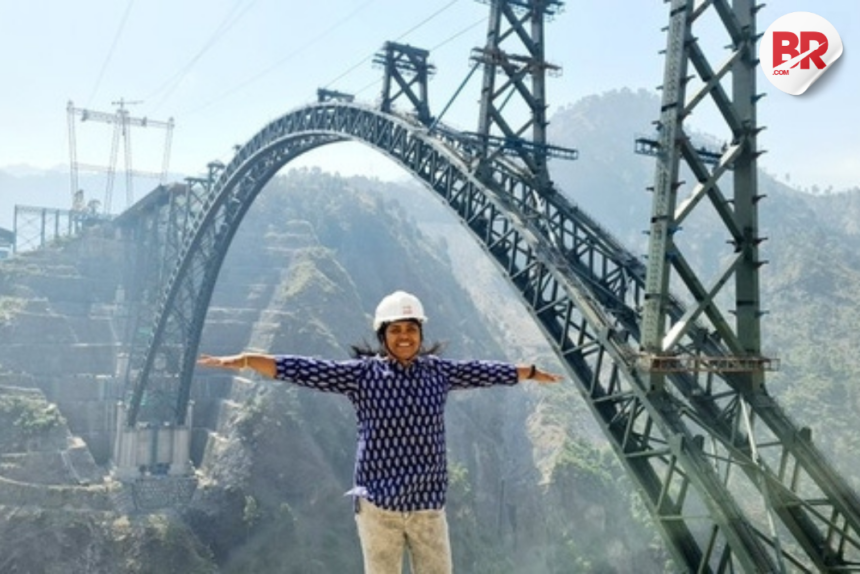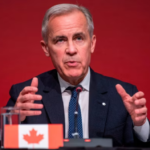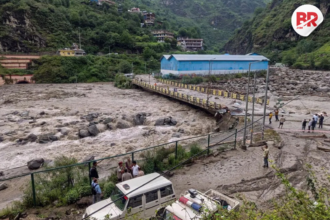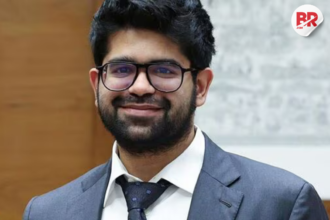
The Chenab Bridge stands 359 metres tall—taller than the Eiffel Tower.
Built in the Himalayas, it’s the world’s highest railway arch bridge. This engineering wonder is part of the Udhampur-Srinagar-Baramulla Rail Link (USBRL), connecting Kashmir to the rest of India with an all-weather railway line.
On 20 February 2024, Prime Minister Narendra Modi flagged off the first Vande Bharat Express from Jammu to Srinagar. The sleek white train now zips through the mountains in under three hours, ending decades of dependence on the risky Jammu-Srinagar highway.

Behind the Bridge? Meet Madhavi Latha
For the average person, the Chenab Bridge means more than faster travel. It means all-weather access to Kashmir. It means stronger defence logistics. It means development. And behind this transformation is Madhavi Latha, a professor at IISc Bengaluru and an expert in rock engineering.
She didn’t just drop in for the final ribbon-cutting. Latha’s role in this project began nearly 17 years ago. Her focus? The unglamorous but vital stuff—slope stability, foundation design, and geotechnical safety. Without her work, this mega project would quite literally be on shaky ground.
From Andhra Village to Engineering Legend
Latha’s journey is just as epic as the bridge. Born in Yedugundlapadu, a small village in Andhra Pradesh, she was the first engineer from her community. She earned her BTech from JNTU Kakinada, an MTech from NIT Warangal, then went on to get a PhD from IIT Madras before joining IISc in 2003.
Northern Railways brought her on board, along with engineering giant Afcons, to advise on some of the most complex challenges in Himalayan construction. Her core job: keep the rocks from slipping, the slopes from collapsing, and the foundations from cracking.
She’s also pioneered image-based soil research—using advanced tech to study how geosynthetics behave under pressure. That research directly helped design safer, smarter systems for the Chenab Bridge.
National Pride, Global Feat
The Chenab Bridge was built at a cost of Rs 1,486 crore. It’s 1,315 metres long with an arch span of 467 metres. It can withstand wind speeds up to 260 km/h and is expected to last 120 years. In a region known for earthquakes and landslides, that’s nothing short of a miracle.
IISc proudly said, “Her work has been pivotal in making this engineering marvel a reality.” And when it comes from IISc? That’s not PR. That’s science-backed swagger.
We are proud of Prof Madhavi Latha & her team’s contribution to the #ChenabBridge inaugurated by Hon’ble PM Narendra Modi🎉
The team worked on stability of slopes, design & construction of foundations, design of slope stabilisation systems incl. rock anchors to withstand hazards. pic.twitter.com/BApCSJTRZX— IISc Bangalore (@iiscbangalore) June 6, 2025
This Bridge Isn’t Just Steel—It’s Symbol
With 255 km of USBRL already done, this is more than infrastructure. It’s a symbol of unity, defence preparedness, and hope for the region. And Madhavi Latha? She’s the quiet force behind the scenes who made sure it didn’t all fall apart—literally.
Because sometimes, national integration rests on a rock-solid foundation. And sometimes, that foundation is a woman from a village who refused to quit.
Also Read No Longer Cut Off: Key Stations Unlocked as Kashmir’s Remote Corners Join the Rail Map












